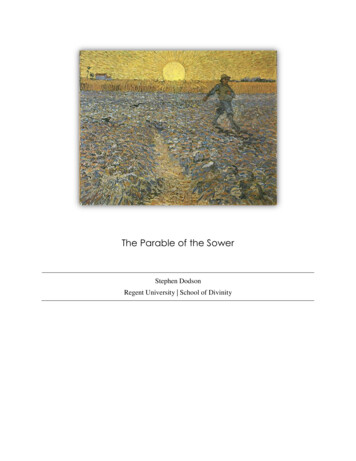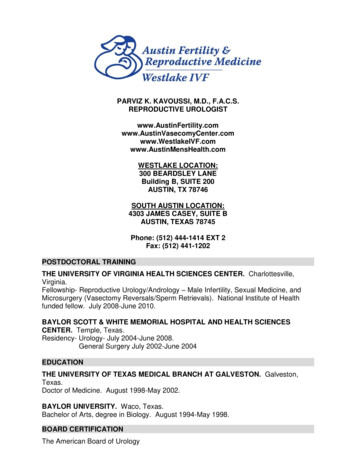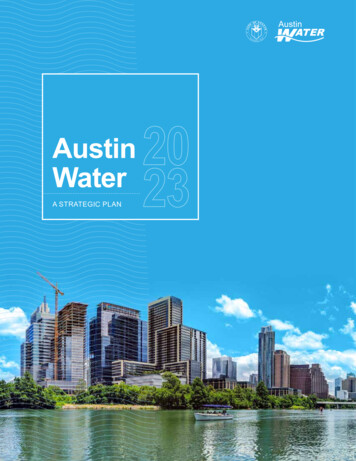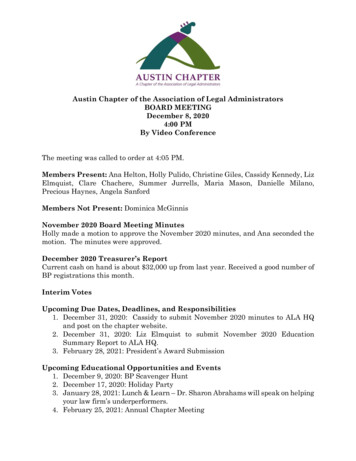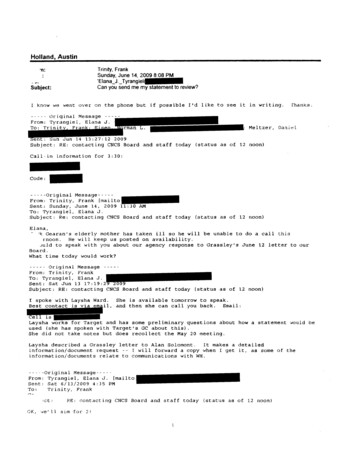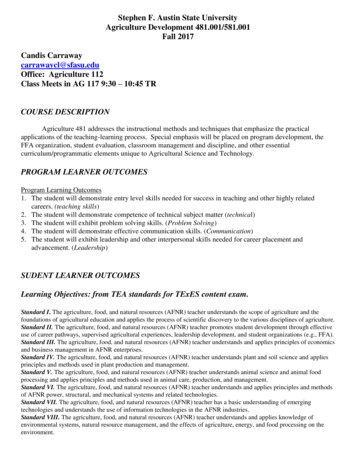
Transcription
Stephen F. Austin State UniversityAgriculture Development 481.001/581.001Fall 2017Candis Carrawaycarrawaycl@sfasu.eduOffice: Agriculture 112Class Meets in AG 117 9:30 – 10:45 TRCOURSE DESCRIPTIONAgriculture 481 addresses the instructional methods and techniques that emphasize the practicalapplications of the teaching-learning process. Special emphasis will be placed on program development, theFFA organization, student evaluation, classroom management and discipline, and other essentialcurriculum/programmatic elements unique to Agricultural Science and Technology.PROGRAM LEARNER OUTCOMESProgram Learning Outcomes1. The student will demonstrate entry level skills needed for success in teaching and other highly relatedcareers. (teaching skills)2. The student will demonstrate competence of technical subject matter (technical)3. The student will exhibit problem solving skills. (Problem Solving)4. The student will demonstrate effective communication skills. (Communication)5. The student will exhibit leadership and other interpersonal skills needed for career placement andadvancement. (Leadership)SUDENT LEARNER OUTCOMESLearning Objectives: from TEA standards for TExES content exam.Standard I. The agriculture, food, and natural resources (AFNR) teacher understands the scope of agriculture and thefoundations of agricultural education and applies the process of scientific discovery to the various disciplines of agriculture.Standard II. The agriculture, food, and natural resources (AFNR) teacher promotes student development through effectiveuse of career pathways, supervised agricultural experiences, leadership development, and student organizations (e.g., FFA).Standard III. The agriculture, food, and natural resources (AFNR) teacher understands and applies principles of economicsand business management in AFNR enterprises.Standard IV. The agriculture, food, and natural resources (AFNR) teacher understands plant and soil science and appliesprinciples and methods used in plant production and management.Standard V. The agriculture, food, and natural resources (AFNR) teacher understands animal science and animal foodprocessing and applies principles and methods used in animal care, production, and management.Standard VI. The agriculture, food, and natural resources (AFNR) teacher understands and applies principles and methodsof AFNR power, structural, and mechanical systems and related technologies.Standard VII. The agriculture, food, and natural resources (AFNR) teacher has a basic understanding of emergingtechnologies and understands the use of information technologies in the AFNR industries.Standard VIII. The agriculture, food, and natural resources (AFNR) teacher understands and applies knowledge ofenvironmental systems, natural resource management, and the effects of agriculture, energy, and food processing on theenvironment.
Standard IX. The agriculture, food, and natural resources (AFNR) teacher knows how to organize and manage an effectiveagriculture, food, and natural resources program and how to work with school, community, and industry representatives tosupport the program.Standard X. The agriculture, food, and natural resources (AFNR) teacher knows how to plan, implement, and utilizeinstruction and student assessment, including academic integration.Standard XI. The agriculture, food, and natural resources (AFNR) teacher understands and applies appropriate safety andrisk management procedures and practices to ensure the safety and well-being of all students in the classroom, laboratory,field, and supervised agricultural experience (SAE).Standards I, II, X, and XI are addressed in this course.COURSE ASSIGNMENTS, ACTIVITES, INSTRUCTIONAL STRATEGIES1.2.In-class assignments/out-of-class assignments may be announced orunannounced but will include a mini teaching unit, lesson plan development, and assignments ina student record keeping system (SAE) online book.Instructional strategies will include lectures, discussion, group participation, field trips, guestspeakers, and videos.EVALUATION AND ASSESSMENTSThree 1 hour exams at 100 pointsOne mini-unit at 100 pointsOne demonstration or presentation at 50 pointsClass participation 100 pointsOutside reading and reports (5 at 10 points each)Final Exam (comprehensive)300 points100 points50 points100 points50 points100 points700 pointsGrading630---700 A560---629 B490---559 C420---489 D.Students taking the course for graduate credit will be expected to complete a research project related toAgricultural Education.To complete Certification/Licensing Requirements in Texas related to public education, you will be required to:1 Undergo criminal background checks for field or clinical experiences on public school campuses; the publicschool campuses are responsible for the criminal background check; YOU are responsible for completing theinformation form requesting the criminal background check; the completed information form is due. If you have a history of criminal activity, you may not be allowed to completefield or clinical experiences on public school campuses. At that point, you may want to reconsider your majorwhile at SFASU.2. Provide one of the following primary ID documents: passport, drivers license, state or providence ID cards, anational ID card, or military ID card to take the TExES exams (additional information availableat www.texes.ets.org/registrationBulletin/) . YOU must provide legal documentation to be allowed to take thesemandated examinations that are related to certification/licensing requirements in Texas. If you do not have legaldocumentation, you may want to reconsider your major while at SFASU.3. Successfully complete state mandated fingerprint background check. If you have a history of criminal activity,you may want to reconsider your major while at SFASU.
RUBRICS USED FOR SCORINGAgricultural DevelopmentAssessment Rubric 2 Teaching SkillsStudent Course DateIntended Outcome: The student will demonstrate entry level skills needed for success in teaching.PerformanceAreaClassroom mCareerDevelopmentEvents andLeadershipDevelopmentEventsThe FFAorganizationMeets and ExceedsExpectations(6-7)Acceptable(4-5)Less ThanAdequate(2-3)LimitedStudent instructional planning,delivery and evaluation includingclassroom management strategies isacceptable or superior. Requireslittle to moderate correctivesupervision.Student instructionalplanning, delivery andevaluation includingclassroom managementstrategies are acceptable for abeginning teacher. Requiressome supervision andfeedback. .Student demonstrates anacceptable level ofunderstanding of theSupervised AgriculturalExperience Program and hasgood working knowledge ofthe on-line record keeping.Student demonstrates marginalplanning, delivery andclassroom management skills.Lesson delivery indicates poorgrasp of instructionaltechniques, lesson pace andstudent evaluation.Student instructionalplanning, delivery,evaluation andclassroom managementstrategies are clearlylacking. Content is poorand ill prepared. .Student concept of thesupervised experience programis limited. Lacks sufficientknowledge of the record keepingsystem to progressindependently.Student is familiar with purposes ofCDE’s and LDE’s and hasdemonstrated a superior level ofability to prepare teams forcompetitions.Student has andunderstanding of CDE’s andLDE’s and has demonstratedan entry level ability toprepare teams forcompetitionsStudent has limited knowledgeof CDE’s and LDE’s and willneed supervision in preparingstudents for team competitions.Student is unable todemonstrate a sufficientunderstanding of thesupervised agriculturalexperience program.Has little knowledge ofstudent record keepingsystems.Student exhibits little tono knowledge of CDE’sor LDE’s and is notcapable of preparingstudents forcompetitions.Student provides exceptionalleadership as beginning FFAadvisor. Demonstrates, for abeginning teacher, superiorknowledge of FFA activities,degrees and awards, and therelationship between classroom/labinstruction and the FFAorganization. Student is able toeffectively prepare an FFA Programof Activities (POA).Student demonstrates theability to serve as an advisorfor the FFA. Has a workingknowledge of FFA activities,degrees and awards and therelationship betweenclassroom/lab instruction andthe FFA. Student is able toutilize resources to plan aPOA.Student fails to demonstrate anunderstanding of the broadscope of FFA activities.Demonstrates little knowledgeof degrees and awards offeredthough FFA membership. Doesnot reliably demonstrate theability to function as aneffective advisor. Has limitedknowledge of the POA.Student demonstrates a superiorunderstanding of the variouscomponents of the SupervisedExperience Program. Is able toassist students with online FFARecord keeping(0-1)Student exhibits little tono knowledge of theFFA organization at anylevel. Could not serveas an effective advisorfor an FFA chapter.Comments:COURSE CONTENT:I.History, principles and foundations of agricultural educationII.Instructional planning.A.B.C.D.III.Determining the needs and interest of studentsSelecting and obtaining student instructional materialsCourse selection and content sequencingTEKS for AFNRPrinciples of LearningMotivation, retention, transfer, reinforcement, association, set, readiness, contrast, andbecoming encouragers of learning.Score
IV.Methods of Teaching Agricultural ScienceA.B.C.D.E.F.G.V.Instructional SkillsA.B.C.D.VI.Formal and informal evaluationTest types and advantages of eachTest reliability and validityGrading and grade reportingContent area readingScientific Investigationa. experimental studyb. Hypothesis testingc, descriptived. types of datacontinuousdiscretemean, mode, medianInstruction of the Exceptional StudentA.B.C.D.VIII.Lesson Focus (interest approach)ObjectivesQuestioning techniquesClosureInstructional Assessment and Student EvaluationA.B.C.D.E.F.VII.Problem Solving (Problem Based Learning)LectureDemonstrationIndividualized InstructionAudio Visual--Computer Assisted Instruction.Field TripsAppreciative InquiryDisabledCulturally differentDisadvantagedGiftedClassroom managementA.B.C.D.Physical EnvironmentInstructional EnvironmentStudent BehaviorRisk Management and teacher liabilityStorage of petroleum based products
MSDS sheetsShop safetyIX.The Supervised Agricultural Experience ProgramA. Record Keeping and reportingB. Criteria for SAE’sC. Child Labor LawsX.The FFA organizationA. Organization1.Program of ActivitiesB. Degrees and AwardsC. Leadership eventsD. Career Development EventsE. Livestock Shows and FairsXI.ProfessionalismA. Association for Career and Technology Education (ACTE)B. National Association of Agricultural EducatorsC. VATATD. Professional Ag WorkersE. Ag WorkersF. ACTG NARRUXII.Departmental managementA.B.C.D.XIII.BudgetingWorking in multi-teacher departmentLaboratory and facility managementPurchasing supplies and equipmentTeaching Adult and Youth GroupsA. Physiological considerationsB. Effective techniquesXIV. Planning and developing a Advisory CouncilXV.The TExES exam.
TENTATIVE SCHEDULEAug 29History and Principles of AgriculturalEducationSept 5Curriculum and Curriculum MappingAug 31Advisory CommitteesSelecting Courses and Course RotationsSept 7Curriculum MappingSept 12Preparing Units of InstructionSept 19Teaching Special Needs Students andClassroom ManagementSept 26Professional Association (continued)Sept 14Parts of a Lesson and Lesson PlanningSept 21Roles of the Ag TeacherProfessionalism and Professional AssociationsSept 28Supervised Agricultural Experience Programs(SAEs)Oct 5SAE Record KeepingOct 12Exhibition of SAEsOct 19FFA – Program of ActivitiesOct 3SAE Record KeepingOct 10College Experience DayOct 17FFA Structure and OrganizationOct 24Mini-Unit Presentations(National FFA Convention)Oct 31Mini-Unit PresentationsNov 7District LDEsNov 14Area IX LDEsNov 21THANKSGIVING HOLIDAYNov 28Managing a FFA ChapterDec 5Life as an Ag TeacherWeek of Dec 11FinalsOct 26Mini-Unit Presentations(National FFA Convention)Nov 2Mini-Unit PresentationsNov 9FFA ContestsNov 16FFA Awards, Degrees, and ScholarshipsNov 23THANKSGIVING HOLIDAYNov 30Managing an Ag Ed ProgramDec 7TExES Exam
Attendance PolicyExcused absences should be approved in advance when possible. After two absences, 5 pointswill be subtracted from your final point total for each absence. To get abscences approved youshould contact your teacher before the class.Academic Integrity (A-9.1)Academic integrity is a responsibility of all university faculty and students. Faculty memberspromote academic integrity in multiple ways including instruction on the components ofacademic honesty, as well as abiding by university policy on penalties for cheating andplagiarism.Definition of Academic DishonestyAcademic dishonesty includes both cheating and plagiarism. Cheating includes but is not limitedto (1) using or attempting to use unauthorized materials to aid in achieving a better grade on acomponent of a class; (2) the falsification or invention of any information, including citations, onan assigned exercise; and/or (3) helping or attempting to help another in an act of cheating orplagiarism. Plagiarism is presenting the words or ideas of another person as if they were yourown. Examples of plagiarism are (1) submitting an assignment as if it were one's own workwhen, in fact, it is at least partly the work of another; (2) submitting a work that has beenpurchased or otherwise obtained from an Internet source or another source; and (3) incorporatingthe words or ideas of an author into one's paper without giving the author due credit.Please read the complete policy at http://www.sfasu.edu/policies/academic integrity.aspWithheld Grades Semester Grades Policy (A-54)Ordinarily, at the discretion of the instructor of record and with the approval of the academicchair/director, a grade of WH will be assigned only if the student cannot complete the coursework because of unavoidable circumstances. Students must complete the work within onecalendar year from the end of the semester in which they receive a WH, or the gradeautomatically becomes an F. If students register for the same course in future terms the WH willautomatically become an F and will be counted as a repeated course for the purpose of computingthe grade point average.Students with DisabilitiesTo obtain disability related accommodations, alternate formats and/or auxiliary aids, studentswith disabilities must contact the Office of Disability Services (ODS), Human Services Building,and Room 325, 468-3004 / 468-1004 (TDD) as early as possible in the semester. Once verified,ODS will notify the course instructor and outline the accommodation and/or auxiliary aids to beprovided. Failure to request services in a timely manner may delay your accommodations. Foradditional information, go to http://www.sfasu.edu/disabilityservices/
Agricultural Development Program Learning OutcomesCourse MatrixProgram Learning Outcomes3. The student will demonstrate entry level skills needed for success in teaching and otherhighly related careers. (teaching skills)4. The student will demonstrate competence of technical subject matter (technical)3. The student will exhibit problem solving skills. (Problem Solving)4. The student will demonstrate effective communication skills. (Communication)5. The student will exhibit leadership and other interpersonal skills needed for career placementand advancement. (Leadership)B.S. Agricultural Development Program Learning Outcomes*CoursePLO 1TeachingAGR 100AGN 110AGM 120ANS 131PLS 252HRT 210PLS 237ANS 242ANS 243PLS 317ANS 343ANS 442AGM 236AGN 331ANS 333AGM 325AGD 361AGD 371AGM 383AGD 400AEC 451AGD 481AGD 491BBBBIBBBBIBBIIBBIIAIBAMB-BasicProficiency LevelsPLO 2PLO 3PLO IAMAAMI-IntermediateA-AdvancedPLO 5LeadershipM-Mastery*Matrix is for academic purposes only and should not be of concern to the student.BIIBAIIBIIIIBIIBAMIAIAM
degrees and awards and the relationship between classroom/lab instruction and the FFA. Student is able to utilize resources to plan a POA. Student fails to demonstrate an understanding of the broad scope of FFA activities. Demonstrates little knowledge of degrees and awards offered






